
04/04
344
Cataloging
Viewing the Weeding log
Every time a copy is deleted, Cataloging adds an entry to this cumulative log.
View this log when ordering replacement materials or creating budgets and
year-end reports. If you want a new log started at the beginning of a school or
fiscal year, make sure to delete the old one.
Cataloging adds an entry to the log when deleting copies manually in the MARC
Viewer, deleting copies after an export, deleting them via PHD or scanner, or
globally deleting lost or missing copies. Please note that the Weeding log does not
include copies deleted by DX or Utilities.
To access the log, from the computer desktop, open the Follett Applications
folder and doubleclick the Exception Reports icon. You can also access the Follett
Applications menu from the Windows Start | Programs menu or from the Mac
OS Apple menu. The log resides in your CC40\TEMP folder. Its file name is
WEEDING.TXT. (If Cataloging cannot write to the WEEDING.TXT file, it creates
another one, WEEDING1.TXT, and enters the information there.)
Note:
If you installed Catalog Plus to your individual workstations, and not to a
server, each Cataloging workstation will have its own Weeding log. In this
case, you'll need to combine the information in the logs.
The log is in a fixed-length ASCII format. That is, every field in the record is a
fixed length. The first record in the log is a header line, containing the names of
the fields included in the file. These fields and their widths are:
Date deleted
12
Member ID
12 (Union Catalog Plus only)
Barcode
16
Title
42
Author
27
Standard number
18
Call number
18
Acquisition date
12
Price
12
Files in this format can be imported into a number of applications. For instance, if
you import the file into a spreadsheet program, you can delete any fields you
don't want, and then sort and filter the data to create custom lists and reports.
For example, to import your Weeding log into MS Excel, launch Excel and open
your Weeding log. When you open any text file, Excel automatically launches a
threestep Import Wizard:
1. Set the Original data type to Fixed width.
2. Set the field widths using the list (above).
(The number of hyphens in the second row indicates the field width.)
3. Keep the default column data format of General.
Summary of Contents for VERSION 6.00
Page 8: ...8 04 04 Notes...
Page 60: ...04 04 60 System Setup Notes...
Page 68: ...04 04 68 System Setup Notes...
Page 114: ...04 04 114 System Setup Notes...
Page 146: ...04 04 146 Circulation Desk Notes...
Page 216: ...04 04 216 Inventory Notes...
Page 254: ...04 04 254 Cataloging Notes...
Page 322: ...04 04 322 Cataloging Notes...
Page 370: ...04 04 370 Cataloging Notes...
Page 394: ...04 04 394 Alliance Plus Notes...
Page 402: ...04 04 402 Alliance Plus Notes...
Page 430: ...04 04 430 Search Stations Notes...
Page 498: ...04 04 498 Reports Notes...
Page 590: ...04 04 590 Reports Notes...
Page 642: ...04 04 642 Appendices Notes...
Page 698: ...04 04 698 Appendices Notes...
Page 726: ...04 04 726 Index...
Page 728: ......
Page 729: ......






























